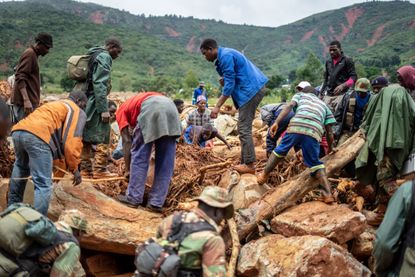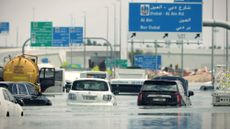Cyclone Idai a ‘massive disaster’ in Mozambique and Zimbabwe
Survivors cling to trees as water levels rise in southern Africa

Cyclone Idai has caused a “massive disaster” in southern Africa affecting hundreds of thousands if not millions of people, says the United Nations.
The cyclone, which caused devastation in Mozambique before striking Zimbabwe and Malawi, has been described as “one of the worst weather-related disasters” in the southern hemisphere.
Reports say the cyclone has destroyed almost everything in its path and caused devastating floods. It has killed and injured thousands of people and ruined crops. The Times says survivors are “clinging to trees and rooftops to escape rising waters”.
Subscribe to The Week
Escape your echo chamber. Get the facts behind the news, plus analysis from multiple perspectives.

Sign up for The Week's Free Newsletters
From our morning news briefing to a weekly Good News Newsletter, get the best of The Week delivered directly to your inbox.
From our morning news briefing to a weekly Good News Newsletter, get the best of The Week delivered directly to your inbox.
More than 2.6m people could be affected across the three countries. Mozambique’s President, Filipe Nyusi, said the death toll could reach 1,000. He called it “a humanitarian disaster of great proportion”.
The United Nations has allocated $20m (£15m) from its emergency response fund to help. Britain is sending up to £6m in aid for victims in Mozambique and Malawi, two of Africa’s poorest countries.
A spokeswoman for the World Meteorological Organisation, Claire Nullis, said: “What we are seeing emerging from our informal networks and from the official databases is if the worst fears are realised... it is one of the worst weather-related disasters in the southern hemisphere.”
Meanwhile, experts say the climate crisis is making deadly storms like this more severe.
Dr Friederike Otto, of Oxford University’s Environmental Change Institute, told The Guardian: “There are three factors with storms like this: rainfall, storm surge and wind. Rainfall levels are on the increase because of climate change, and storm surges are more severe because of sea level rises.”
Paulo Ceppi, of the Grantham Institute at Imperial College London, agreed, saying: “There is a direct link between global warming and cyclone intensity.”
Create an account with the same email registered to your subscription to unlock access.
Sign up for Today's Best Articles in your inbox
A free daily email with the biggest news stories of the day – and the best features from TheWeek.com
-
 The toilet roll tax: UK's strange VAT rules
The toilet roll tax: UK's strange VAT rulesThe Explainer 'Mysterious' and 'absurd' tax brought in £168 billion to HMRC last year
By The Week UK Published
-
Why is Tesla stumbling?
In the Spotlight More competition, confusion about the future and a giant pay package for Elon Musk
By Joel Mathis, The Week US Published
-
 How Taylor Swift changed copyright negotiations in music
How Taylor Swift changed copyright negotiations in musicunder the radar The success of Taylor's Version rerecordings has put new pressure on record labels
By Theara Coleman, The Week US Published
-
 What is rock flour and how can it help to fight climate change?
What is rock flour and how can it help to fight climate change?The Explainer Glacier dust to the rescue
By Devika Rao, The Week US Published
-
 Arid Gulf states hit with year's worth of rain
Arid Gulf states hit with year's worth of rainSpeed Read The historic flooding in Dubai is tied to climate change
By Peter Weber, The Week US Published
-
 The growing thirst for camel milk
The growing thirst for camel milkUnder the radar Climate change and health-conscious consumers are pushing demand for nutrient-rich product – and the growth of industrialised farming
By Harriet Marsden, The Week UK Published
-
 Why curbing methane emissions is tricky in fight against climate change
Why curbing methane emissions is tricky in fight against climate changeThe Explainer Tackling the second most significant contributor to global warming could have an immediate impact
By Richard Windsor, The Week UK Published
-
 How the EU undermines its climate goals with animal farming subsidies
How the EU undermines its climate goals with animal farming subsidiesUnder the radar Bloc's agricultural policy incentivises carbon-intensive animal farming over growing crops, despite aims to be carbon-neutral
By Harriet Marsden, The Week UK Published
-
 Why are people and elephants fighting in Sri Lanka?
Why are people and elephants fighting in Sri Lanka?Under The Radar Farmers encroaching into elephant habitats has led to deaths on both sides
By Chas Newkey-Burden, The Week UK Published
-
 How climate change is contributing to global unrest
How climate change is contributing to global unrestIn Depth Some experts argue that global warming can be tied to rising levels of violence around the world
By Justin Klawans, The Week US Published
-
 Why last-chance tourism is the latest controversial travel trend
Why last-chance tourism is the latest controversial travel trendThe Explainer Race to visit places threatened by climate change 'before it's too late'
By Austin Chen, The Week UK Published